The British Pound is the currency of the United Kingdom and 9 British Overseas Territories. Its name comes from the Latin “pound”, which was a unit of weighing used in ancient times.
As for the surname, “sterling”, it comes from the “sterling”, silver coins minted around the year 775 in the Saxon kingdoms. 240 sterling coins were made from one pound of silver, the weight of which was probably roughly equal to the pound.
The pound is the world’s third most active currency after the US dollar and the euro. The pound sterling has been divided since its 1971 decimalization into 100 pence (penny or plural pence).
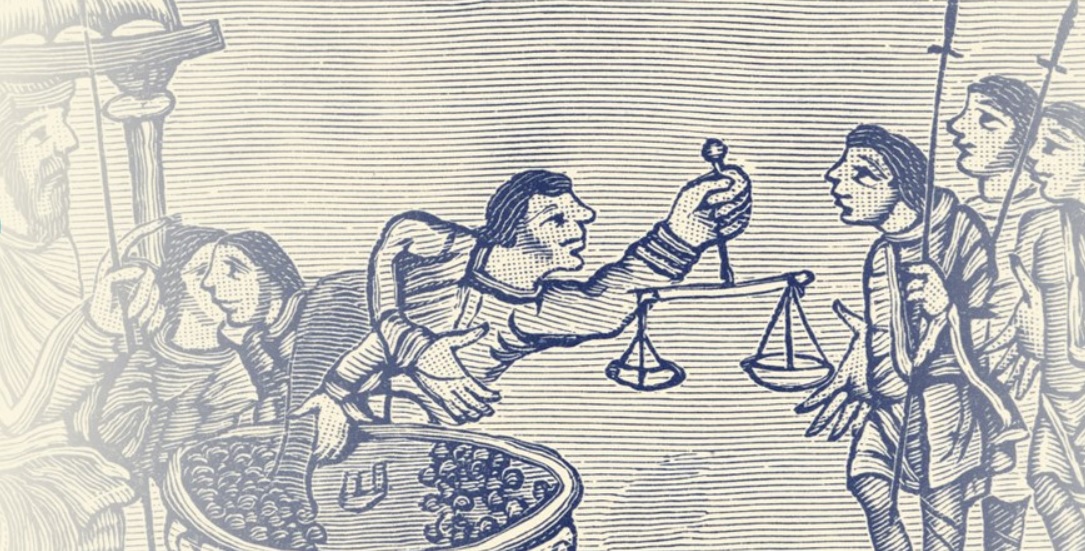
Origins of the pound
The pound was originally the weight value of one Sterling Silver Tower Pound (hence called “sterling”). Specifically, it was the basic Roman unit of weight, which was derived from the Latin “balance”.
The pound`s symbol
The ISO 4217 code for the pound is GBP, which stands for Great Britain pound. Pounds are also colloquially known as “quid” in the singular and “quids” in the plural.
The symbol for the pound today is this “£”. Although originally it was this other one, ₤, similar but with two crossed bars.
This symbol is formed from the letter “L”, from the abbreviation LSD (librae, solidi, denarii) that was used respectively for pounds, shillings and pence in the original duodecimal monetary system.
For its part, the penny symbol is a pe “p”. Colloquially, the 50 pence (£0.50) coin is usually pronounced as “fifty pee” rather than “fifty pence” (this is to help distinguish between new and old pence during currency exchange).
Pound notes
There are currently £5, £10, £20, £50 notes in circulation, and they exist, although notes in denominations of £1 or £100 are in short supply.
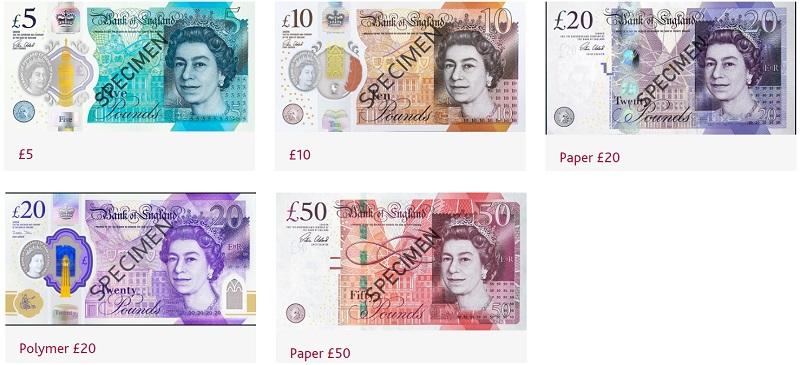
The body in charge of issuing these banknotes is the Bank of England. Here you can see the legal tender pound notes today in case you are planning a trip to London. This series, dating from 2016, stands out for being made of polymer.
5 pound note
The 5 pound note is the lowest value. It measures 125mm x 65mm and its equivalent value in May 2022 in France would be around 5.11 – 5.40 euros.
It has blue and greenish colors and in the last series of September 13, 2016, it shows on its obverse the effigy of Queen Elizabeth II.
The reverse shows politician Sir Winston Churchill standing next to Parliament (Westminster) and the Elizabeth Tower (containing Big Ben) from London’s South Bank, looking across Westminster Bridge. Churchill served as Prime Minister of the United Kingdom for two terms, 1940-1945 and 1951-1955.
Also shown in the background image is the Nobel Prize in Literature medal, which Churchill received in 1953, along with the wording of the award citation.
And the famous quote ‘I have nothing to offer but blood, toil, tears and sweat’ in his first speech on May 13, 1940 in the British Parliament, in the middle of World War II.
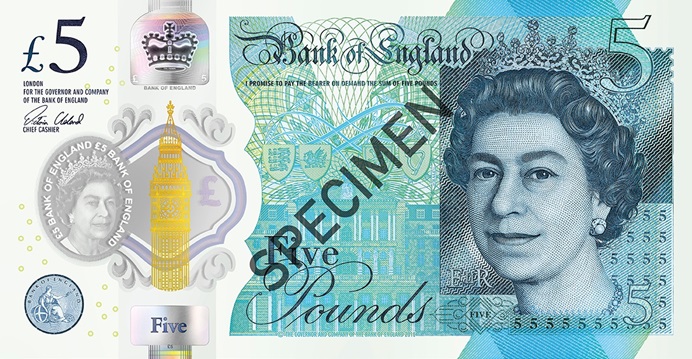
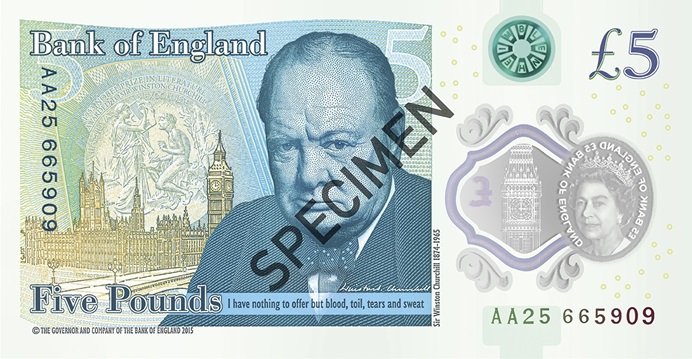
Old version of the £5 note
Be careful, because the 2002 £5 note is no longer valid, although it can be taken to a British post office or a bank to receive its new value.
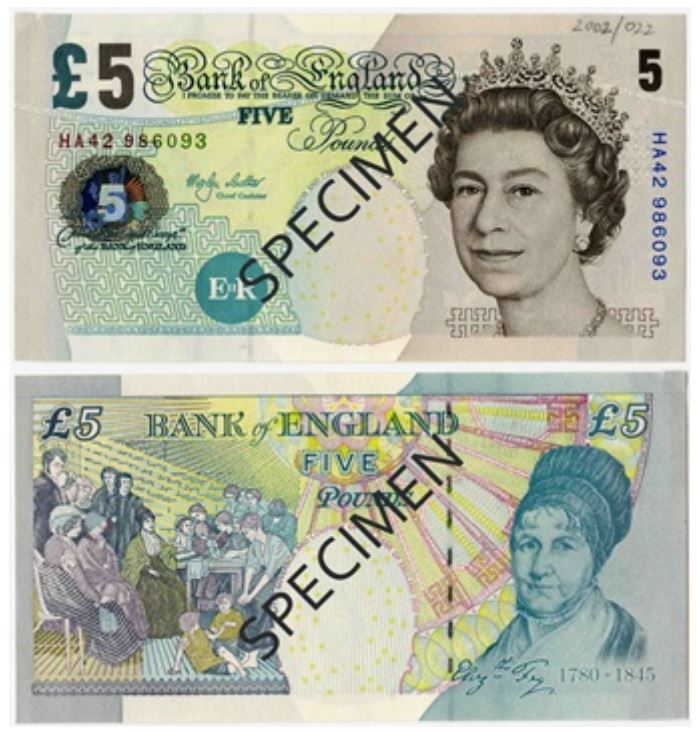
10 pound note
The £10 note has brown and orange colors and measures 132mm x 69mm.
In the last series of September 14, 2017, it shows on its obverse the effigy of Queen Elizabeth II. The counter value of this ten pound note in May 2022 in France would be around 11.20 euros.
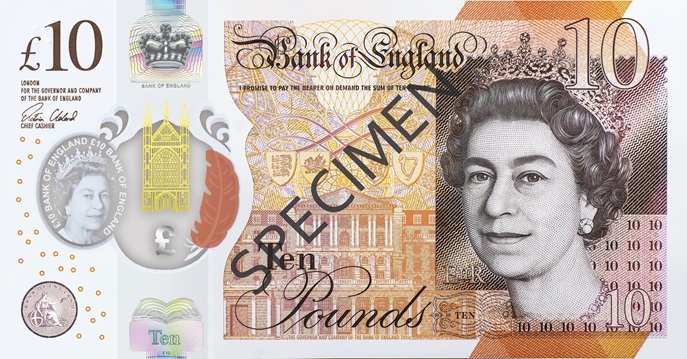
And its reverse shows the portrait of the writer Jane Austen (1875-1917), author of books such as “Pride and Prejudice”, or “Sense and Sensibility”. It was issued in 2017 with the intention of honoring the 200th anniversary of the death of the famous writer.
The note shows the quote ‘I declare after all there is no enjoyment like reading!’ in the voice of the character Miss Bingley from “Pride and Prejudice”.
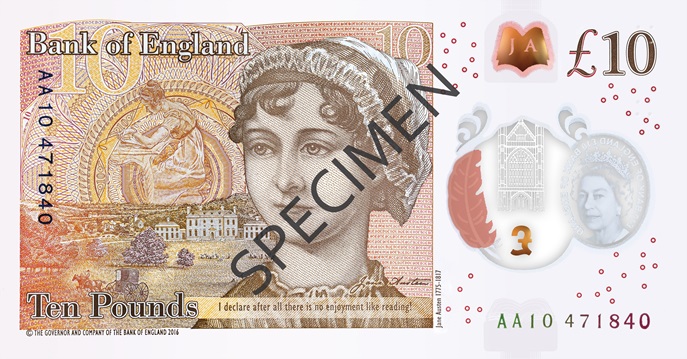
Jane Austen was an English novelist who, through social observation, portrayed 19th-century life in her books, often praising the virtues of reason and intelligence and highlighting some of the barriers that society erected against the progress of women. Her books have been translated into more than 40 languages, of which there have been countless film and television adaptations.
Jane began writing when she was just 11 years old, and by age 23 she had already penned early versions of some of her most famous novels, including Pride and Prejudice and Sense and Sensibility. All of Jane’s work was published anonymously, so although her work was generally well received and even fashionable in some circles, she achieved little recognition until after her death.
This banknote replaces the previous design dedicated to Charles Darwin, which was withdrawn from circulation on March 1, 2018.
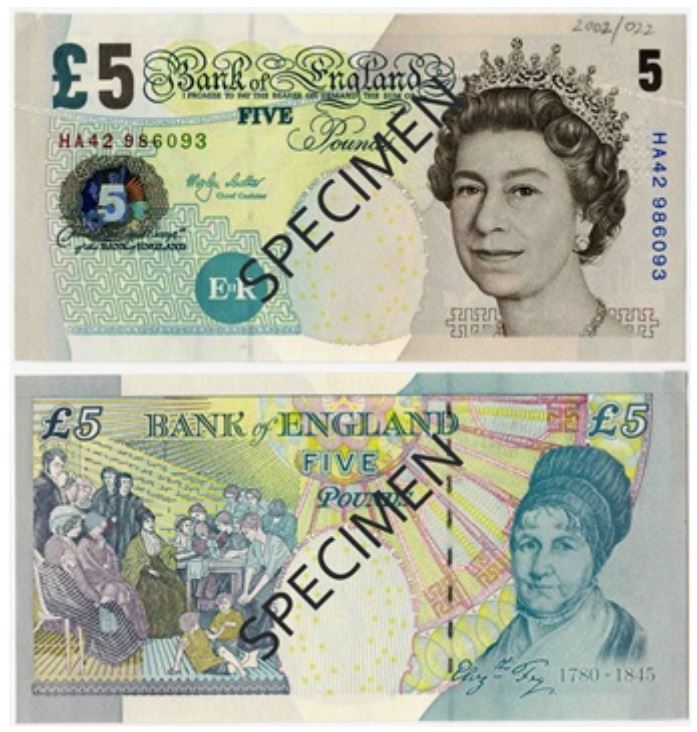
For a 10-pound bill today, May 31, 2022, in France, at a currency supplier or at your bank, they would give you 11.20 euros.
20 pound note (polymer)
The 20 pound note has shades of blue and purple. In the current series dated February 20, 2020, made of polymer, it shows the effigy of Queen Elizabeth II on its obverse and the English landscape painter JMW Turner (1775-1851) on the reverse.
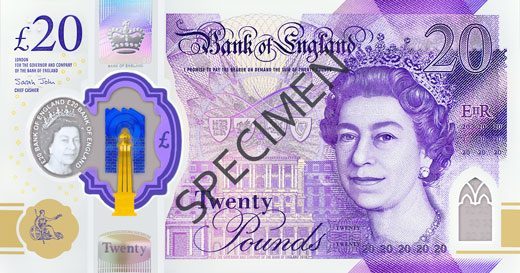
And this is the reverse, dedicated to the landscape painter Joseph Mallord William Turner. It is a self-portrait of the author about 1799 and exhibited at the Tate Britain.
Also shown in the background is “The Fighting Temeraire,” one of Turner’s most famous paintings, paying homage to the warship HMS Temeraire, which played a prominent role in Nelson’s victory at the Battle of Trafalgar in 1805.
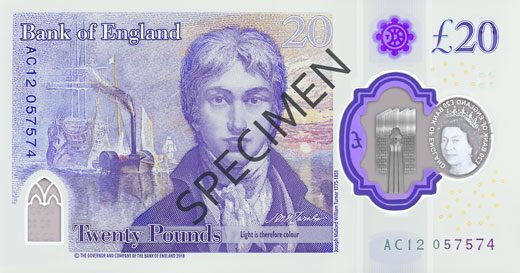
The counter value of this 20 pound note in May 2022 in France would be around 22.40 euros.
Withdrawal of the 20 pound paper note
This is the previous edition of March 13, 2017, made on paper and, be careful, it will be out of circulation on September 30, 2022.
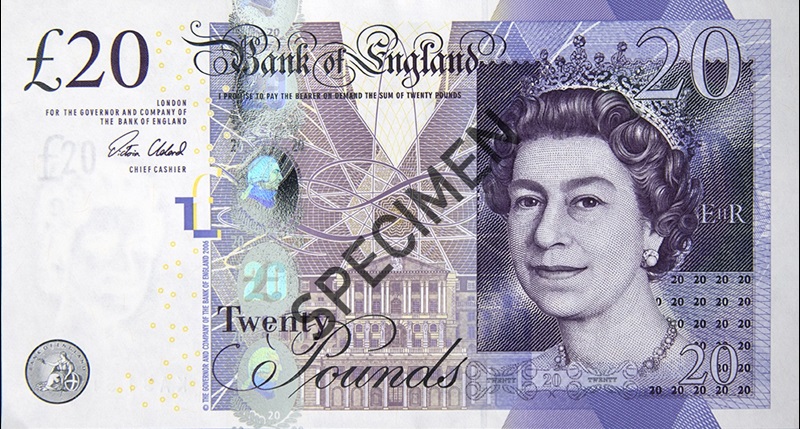
For its part, the reverse is dedicated to the Scottish economist and philosopher Adam Smith (1723-1790), author of important works such as the Wealth of Nations.
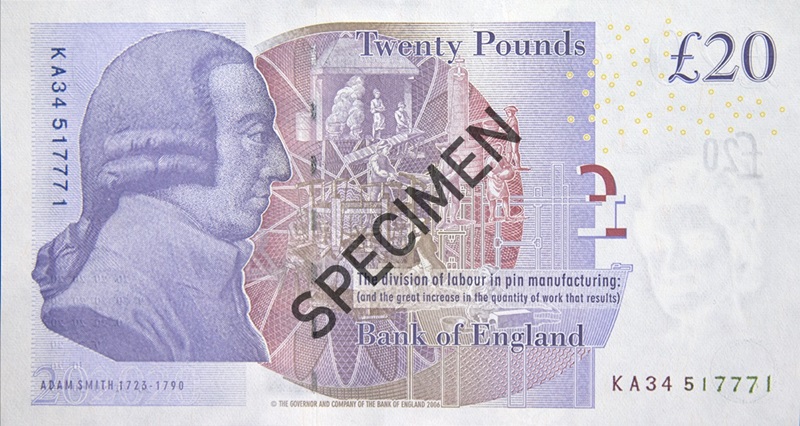
Remember that on September 30, 2022, the 20-pound paper note will be out of circulation.
50 pound note (polymer)
The most recent £50 note in circulation in the UK is dated June 23, 2021. It measures 146 x 177mm and has reddish tones. It shows a portrait of Queen Elizabeth II on the obverse.
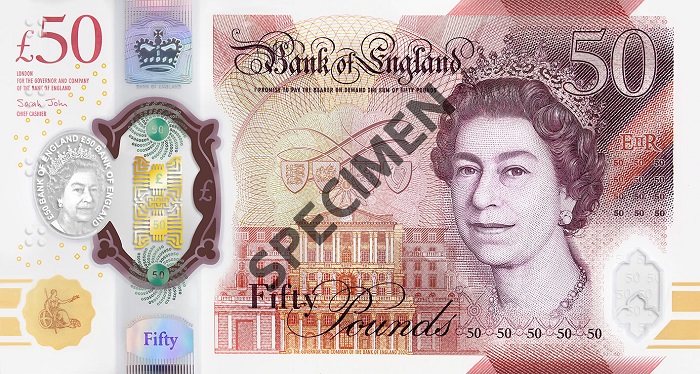
The reverse is dedicated to Alan Turing (1912-1954), a British mathematician, logician, theoretical computer scientist, cryptographer, philosopher, and theoretical biologist. He is considered one of the fathers of computer science and a forerunner of modern computing.
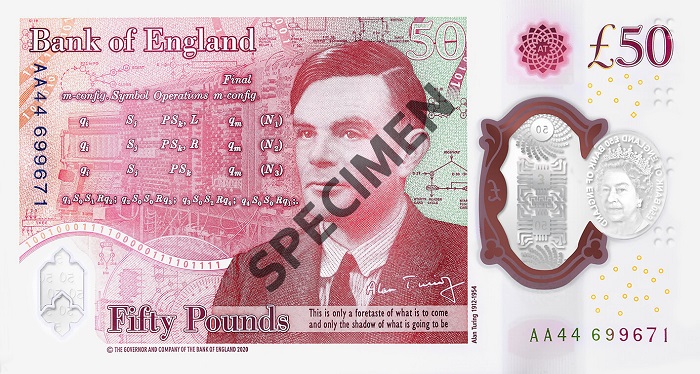
The counter value of this fifty pound note in May 2022 in France would be around 56 euros.
Withdrawal of the 50 pound paper note
As with the £20 note, the paper £50 note of the November 2, 2011 series will be withdrawn from circulation on September 30, 2022.
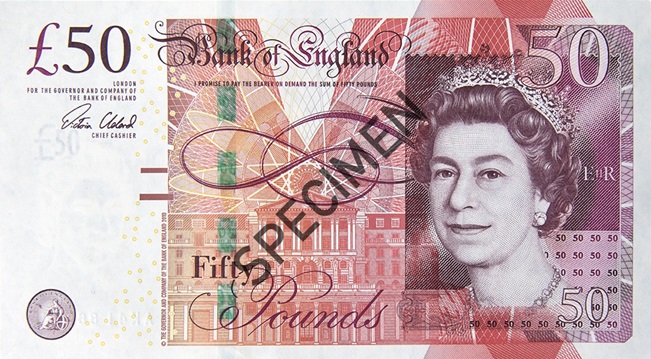
The reverse is dedicated to Boulton and Watt, the leading lights of the industrial revolution. Boulton was an entrepreneur, while Watt was an engineer and scientist who made revolutionary changes to the efficiency of the steam engine.
In 1775, the two formed a partnership to develop and market steam engines, and the designs were adopted throughout the world. The metric unit of power is named after James Watt.
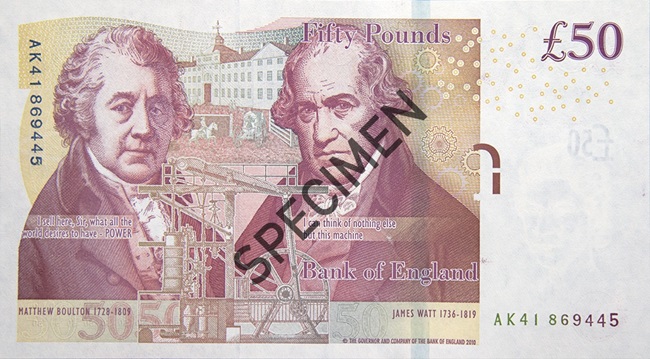
Pound coins
As for the coins in circulation, there are (pence), 1p, 2p, 5p, 10p, 20p, 50p and (pounds) £1 and £2. There is also a 5 pound coin, although with little circulation, more dedicated to collecting.
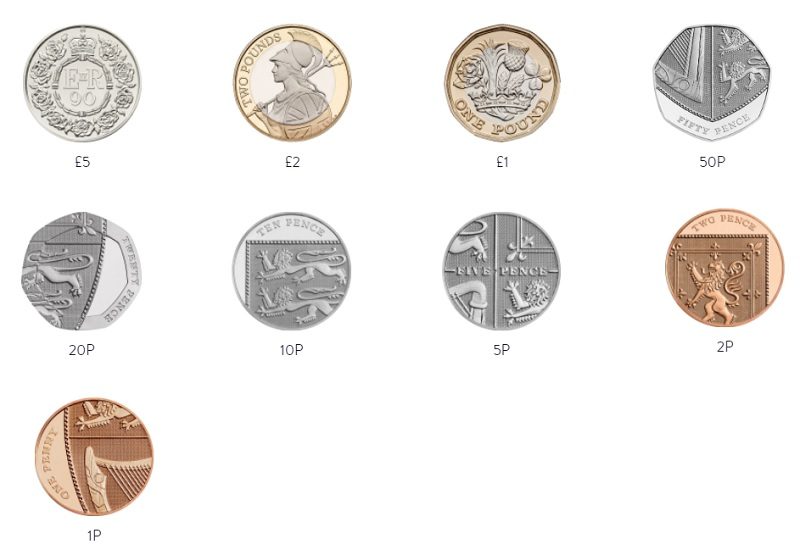
The body in charge of minting these coins is “The Royal Mint“, which in addition to producing currency for the United Kingdom does so for 60 other countries.
2 pound coin
The £2 coin was released in the UK on June 15, 1998, in two different versions of Queen Elizabeth II’s portrait, which has led to some confusion about its validity, but both are in circulation.
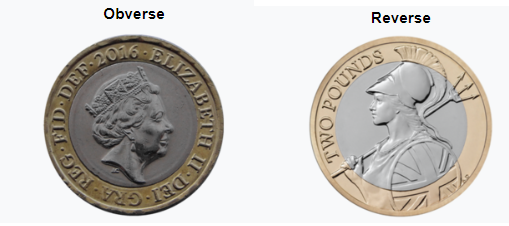
1 pound coin
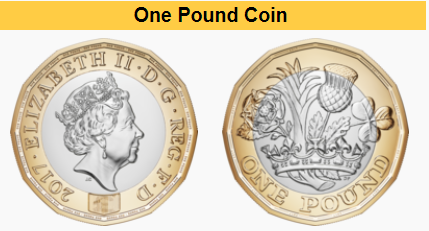
Launched on March 28, 2017, this you see is the safest currency in the world. At least it is so for its coiner, the Royal Mint.
It is a 12-sided bi-metallic coin (the golden outer ring is nickel-brass and the inner silver is a nickel-plated alloy). This characteristic makes it easily recognizable to the touch of people with vision problems, since the previous one pound coin was round.
Its reason for being is the fight against currency counterfeiting. Not surprisingly, it is estimated that 1 out of every 30 round pound coins (the previous ones), was a fake. Hence its relaunch in 2017.
Its dimensions are:
- Thickness: 2.8mm (thinner than the round £1 coin).
- Weight: 8.75g (lighter than the round £1 coin).
- Diameter: 23.43 mm, slightly larger than the round £1 coin.
As of October 15, 2017, the round one pound coin is no longer in circulation in the UK.
The pound in the world
In some British Overseas Territories (British Overseas Territories) the pound is used today as in Jersey, Guernsey, the Isle of Man, South Georgia and South Sandwich Islands, 1,390 km southeast of the Falkland Islands, the territory British Antarctic or Tristan da Cunha
In the rest, other currencies are used that are referenced to the pound sterling. We are talking about the Gibraltarian pound (Gibraltar), the Falkland Islands pound (Islas Malvinas off Argentina) or the Santa Elena pound (122 km2 archipelago in West Africa).
On the Caribbean island of Anguilla the East Caribbean Dollar is used, in Bermuda the Bermudian dollar, on the Pitcairn Islands the New Zealand dollar and on the Cayman Islands its local dollar. In Montserrat the East Caribbean dollar.
Finally, in Akrotiri and Dhekelia (sovereign bases of the United Kingdom on the island of Cyprus) the euro is used.
And in the Caribbean Turks and Caicos Islands and the British Virgin Islands, despite being British Overseas Territories, the US dollar is used.
Euro to pound exchange rate
The exchange rate of the euro against the pound oscillates at all times. If you search Google for “euro-pound exchange rate” you will find dozens of websites that offer a “price” of the day, even with Google Finance prices.
Something like this (prices for the last 12 five years as of July 10, 2022:
As you can see, the change in the last five years has fluctuated between 0.70 and 0.9 pounds per euro, but keep in mind that this graph represents the value of the “currency” against the euro, and not that of the currency. currency, which is lower (worse).
In fact, in currency suppliers in France you can buy pounds sterling at an exchange rate of between 0.83 and 0.66 pounds for each euro depending on where you change. Nothing to do with the euro-pound currency exchange.
But keep this in mind:
-This is an unreliable price. That is, if you click on the “Disclaimer” link, you get this warning from Google Finance: “Google cannot guarantee the accuracy of the exchange rates displayed. Please confirm the current rates before making a transaction that may be affected by fluctuations in exchange rates.
-These prices that you see are usually wholesale prices of the pound currency against the euro currency (currency and currency are not the same);
-This price can only be obtained by banks among themselves, that is, it is impossible to obtain it as an individual.
If you need pounds in bills you will have to go through the ticket retail market (bank or currency supplier). This market means that the pounds have had to be “carried” by someone for you to enjoy them. In other words, moving banknotes from one place to another has logistical costs that will make its sale price more expensive (the exchange rate that whoever sells it will apply to you).
-The pound is a very common and abundant coin / currency in France, so it is easy to find it available (it is always available for sale), since the currency suppliers that receive tourists who use the British currency, change it for euros when they visit us.
Therefore, the currency suppliers and banks have abundant stocks and dispose of the currency at reasonable exchange prices.
Where to exchange British Pounds in France
The 2 most popular places to exchange pounds in France are banks and currency suppliers, high street and at the airport. It could also be done privately, of course, but it’s not worth it because, as France is a country that receives about 90 million tourists a year, of which 25% are Brits, there are no problems with the supply of pounds.
However, the least recommended places to exchange euros for pounds are, in this order:
- airports because they share revenue with the airport manager and are very expensive.
- banks: practically all of them charge you a commission of around 3% of what you change, with a minimum of 10 euros. For example, if you change 1000 euros to pounds, they will charge you between 25 and 30 euros of commission in addition to the change that they apply to you.
- any currency supplier that charges you a commission in addition to an “exchange margin” (difference between the price for which the currency was paid and the price for which it is sold to you). Normally, if you make an online reservation on their websites to pick up the pounds at their office, you save this commission.
Exchange rate euro pound today
The euro to pound currency exchange today is one euro equals 0.85 pounds.
To find out the euro to pound exchange rate today (banknotes, not currencies) at exchange houses, banks and the airport in France, the best thing you can do is use our currency comparator. Click on the link of your interest depending on whether you want to buy pounds or sell them in exchange for euros:
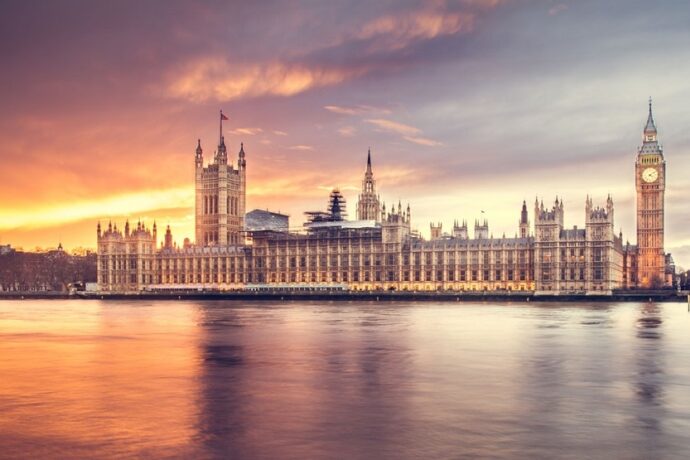
1 Comentarios
One Reply to “The pound sterling (GBP)”